

William Stopford
The cars axed in 2025 that we'll miss the most
1 Day Ago
A polished drive, an attractive interior and a thrifty powertrain are just a few of the reasons the Hyundai Santa Fe Hybrid is worth a look.
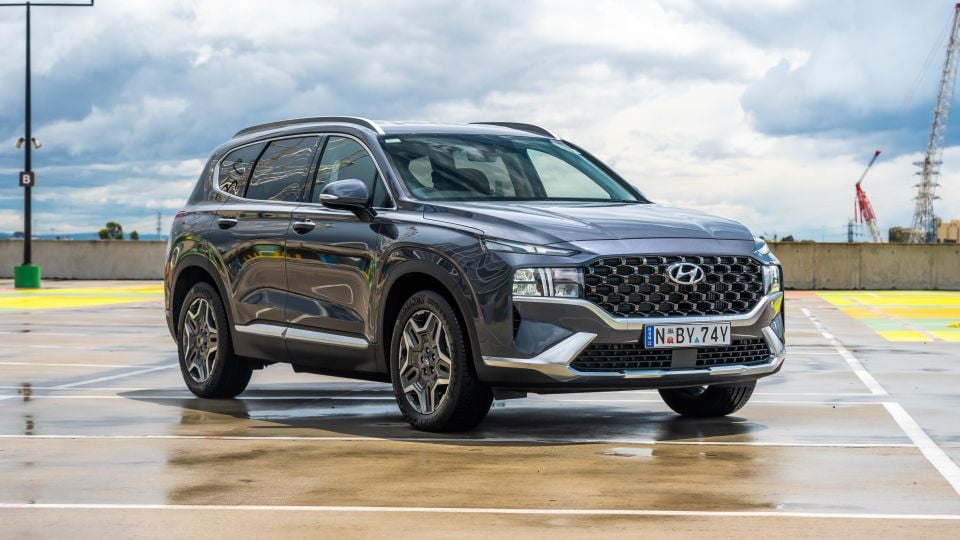
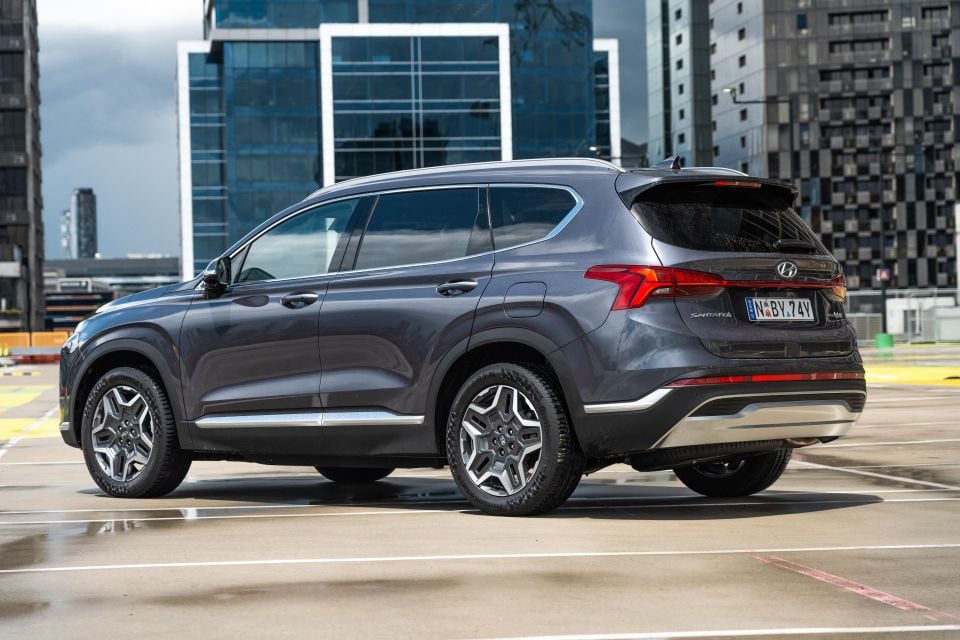

Quickly see how this car stacks up against its competition. Select any benchmark to see more details.
Where expert car reviews meet expert car buying – CarExpert gives you trusted advice, personalised service and real savings on your next new car.
Hyundai says at the moment it has strong availability of its Santa Fe Hybrid, which may just be enough to coax you over from choosing its more supply-constricted hybrid Kia Sorento and Toyota Kluger rivals.

But there’s more to recommend the hybrid Hyundai for than simply short wait times. Though a new generation will debut this year and likely go on sale in Australia next year, the current car was extensively overhauled less than three years ago.
The thrifty hybrid joined the local line-up towards the end of 2022, and it’s already outselling the base petrol V6.
Of course, the diesel still accounts for the lion’s share of sales but if you’re diesel-averse, the hybrid makes for a compelling alternative – not to mention a tantalising substitute for a Sorento or Kluger.
While petrol and diesel Santa Fes are available in base, Active, Elite and Highlander trim levels, the Hybrid is available only in those two highest trim levels.
Our tester is an Elite Hybrid, priced at $63,000 before on-road costs. That’s a steep $6500 premium over the petrol Elite, though you gain all-wheel drive in addition to the hybrid powertrain.
The premium over the diesel Elite is $3000.
Our tester had the optional Cognac Brown interior which is absolutely worth the extra $295, while all paint finishes bar Glacier White and White Cream add an extra $695 to the price tag.
The drive-away price, based on a New South Wales postcode, came to $69,323.
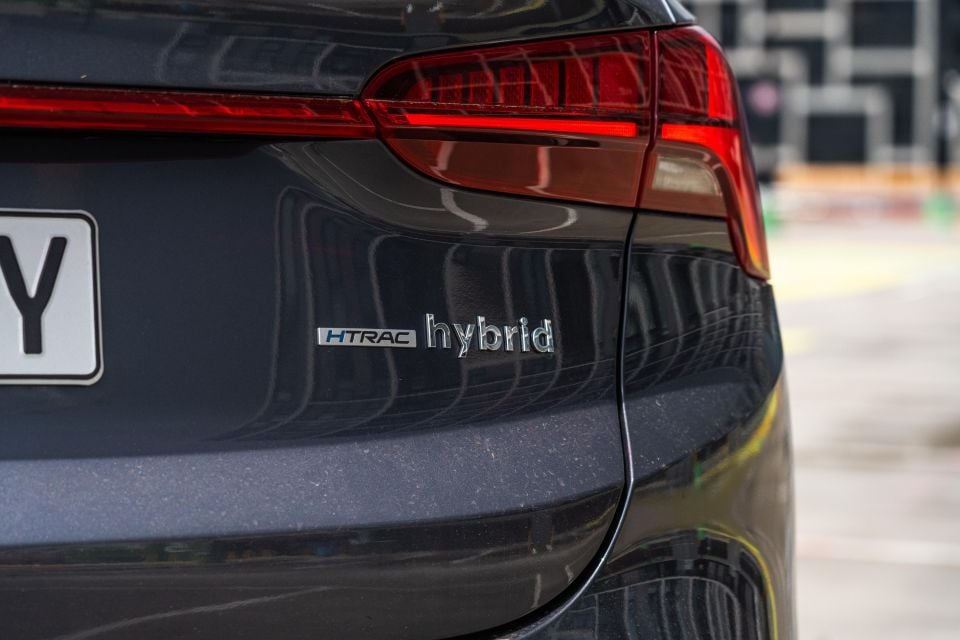
The Kia Sorento Hybrid has the same powertrain, but comes only in one trim level if with a choice of front- or all-wheel drive. The FWD model is $72,322 drive-away, while the AWD model is $75,472 drive-away.
The Toyota Kluger Hybrid is AWD-only, and in mid-range GXL guise rings up at $73,350 drive-away in NSW ($67,140 before on-roads).
Buy your new car without the stress. It's fast, simple and completely free.

Great service from Travis and team, second time I have used this business would not hesitate to recommend them to anyone
Craig C.
Purchased a Ford Ranger in Sunshine Coast, QLD
CarExpert helped Craig save thousands on his Ford Ranger, now let us save you on your next new car.
Find a dealThe Santa Fe Hybrid’s cabin is well-built with an attractive array of materials, and the optional Cognac Brown option further elevates the space.
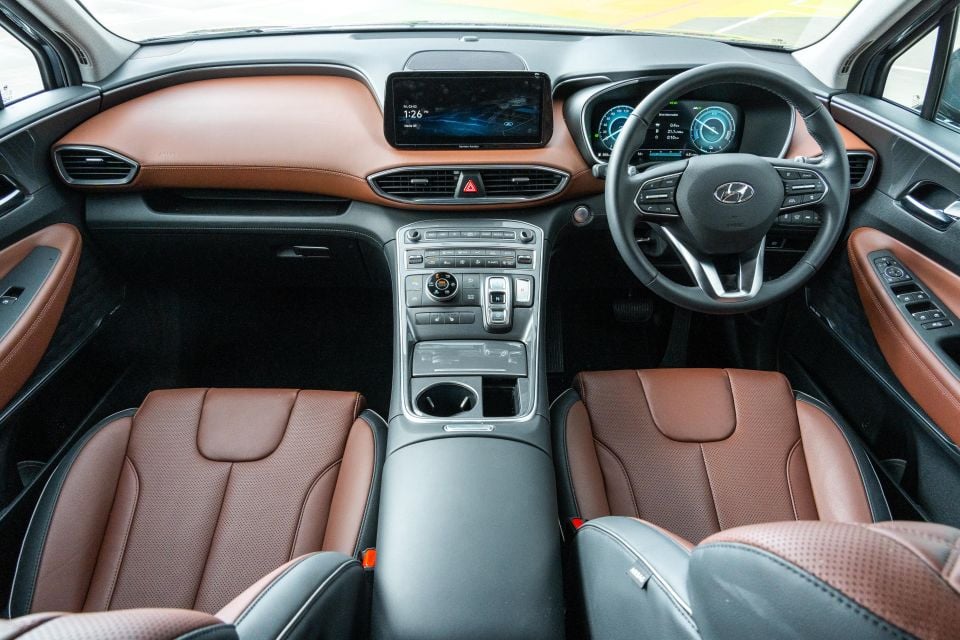
There are stitching details on the armrests, the sides of the centre console and across the dash. The stitching on the top half of the dash gives it the appearance of being wrapped in leather, an elegant touch, while the application of soft-touch trim on the sides of the console where your knee might rest is most welcome.
There’s a big piece of hard plastic trim on the upper half of the doors, but it’s otherwise hard to find fault with this interior. Even the knit headliner is nice to the touch, while the diamond-patterned, metal-look trim is proof you don’t need gloss black trim to provide contrast. Other automakers should take note.
There’s a shelf on the passenger side of the dash where you can put a phone, as well as a spacious shelf below the bridge-like centre console that’s large enough to fit some handbags; down here you’ll also find USB-A and 12V outlets.
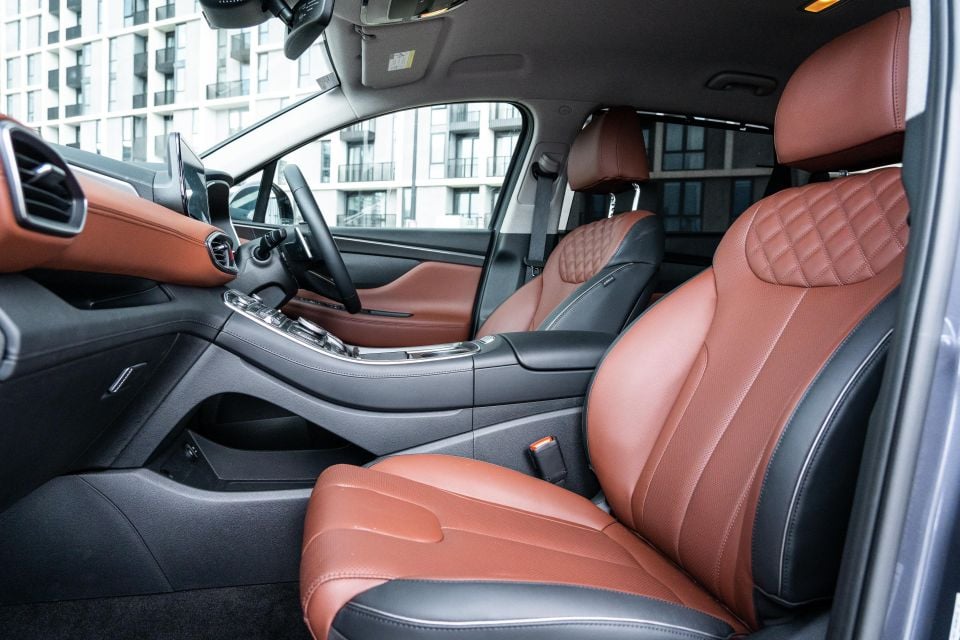
The centre console storage bin is also a good size, though the cupholders being at staggered heights is an odd touch, as are the bottle holders in the doors that don’t allow you to easily stand up a bottle.
The latter reminds me of my Genesis, as does the Santa Fe Hybrid’s inability to remember your auto hold and heated seat settings upon startup.
The centre console is a little daunting at first, appearing to have a sea of buttons. But we’ll take this over an interior that’s too reliant on a touchscreen. It helps, too, that there’s a mix of tactile buttons, knobs and rocker switches.
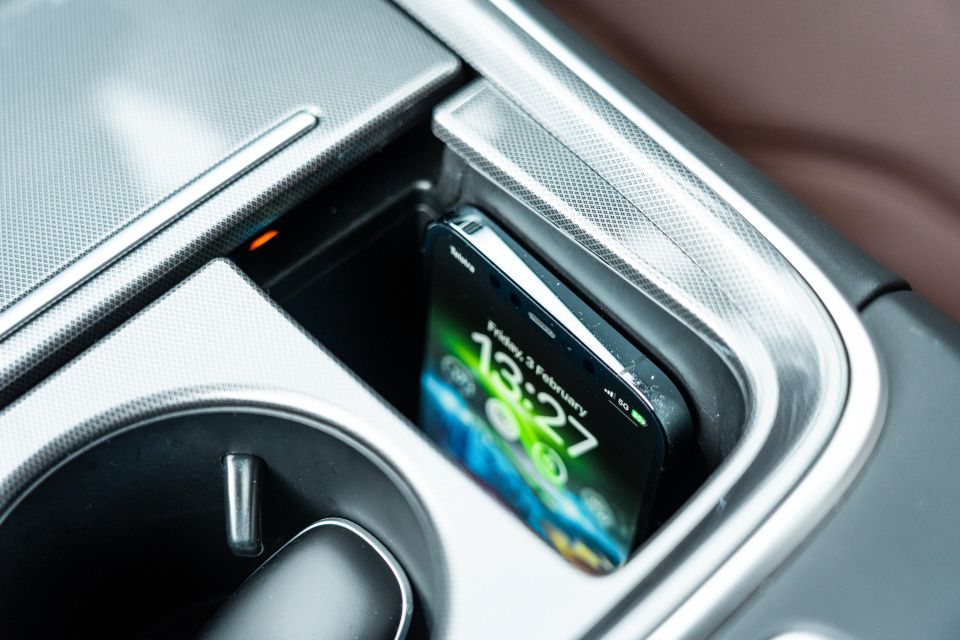
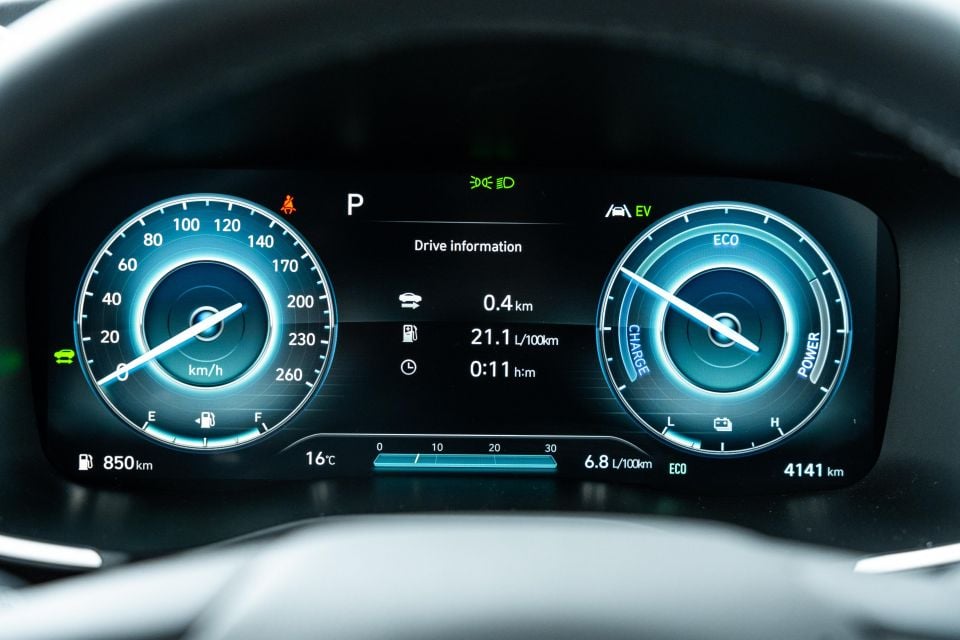
The touchscreen infotainment system is easy to use and attractively presented in typical Hyundai fashion, though there’s still no wireless smartphone mirroring. You’ll need a cable to use Android Auto or Apple CarPlay.
There’s no map view in the digital instrument cluster, but you do enjoy attractive displays and different ‘skins’ that are by default assigned to the different drive modes.
The Harman Kardon sound system was surprisingly disappointing given the brand’s reputation. We fiddled with the settings quite a bit trying to improve the sound quality but it still sounded rather distant and tinny.
We also question the design of the wireless phone charger. On one occasion, my phone didn’t charge as it got too hot. One wonders if that’s because there’s insufficient airflow, as it’s essentially a vertical pit.

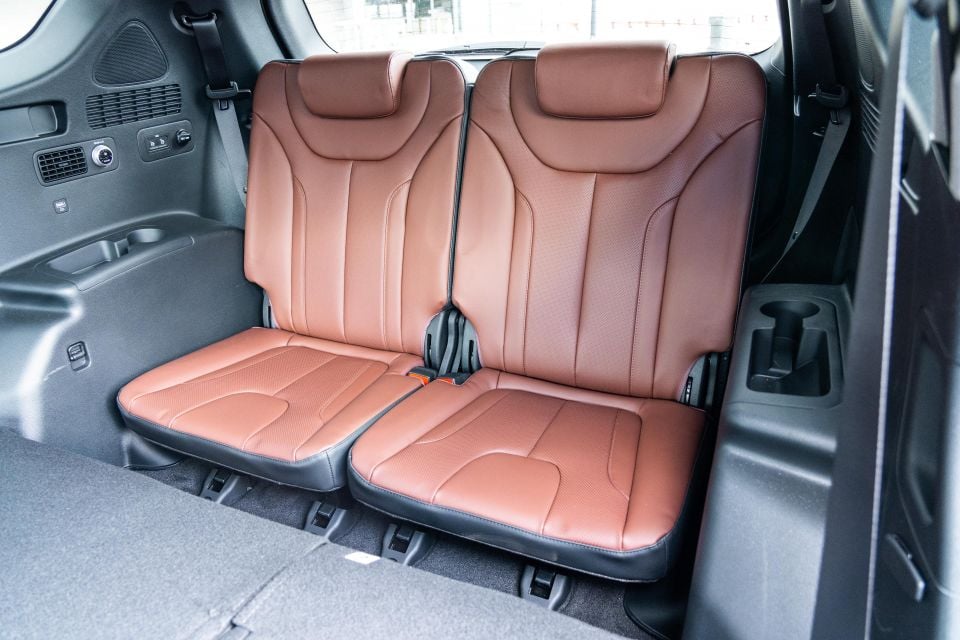
Step into the back and you’ll find a commodious second row. There’s a fairly flat floor with minimal intrusion from the centre tunnel, and occupants enjoy air vents and a pair of USB-A outlets plus a fold-down armrest.
A switch on the side of the kerbside seat automatically tumbles and slides the seat forward.
There are only child-seat anchor points in the second row: three top-tether, plus an ISOFIX point for each of the outboard seats.
In the third row, my head was up against the roof and my knees against the seatbacks. For reference, I’m 180cm tall. It’s really no worse than a Kluger back here, but it’s still best-suited for children. The boxier next-generation model may rectify this issue.
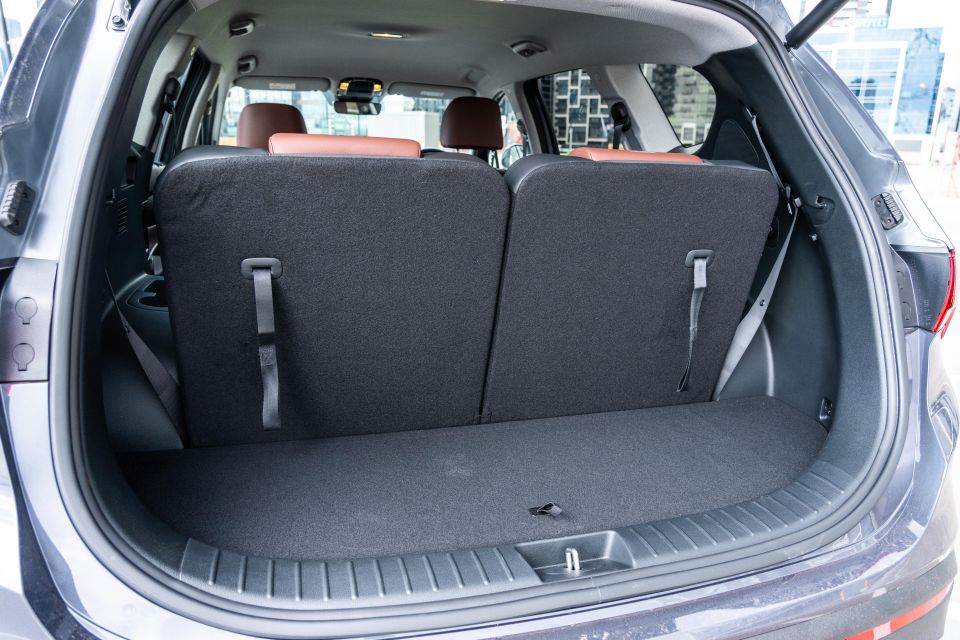
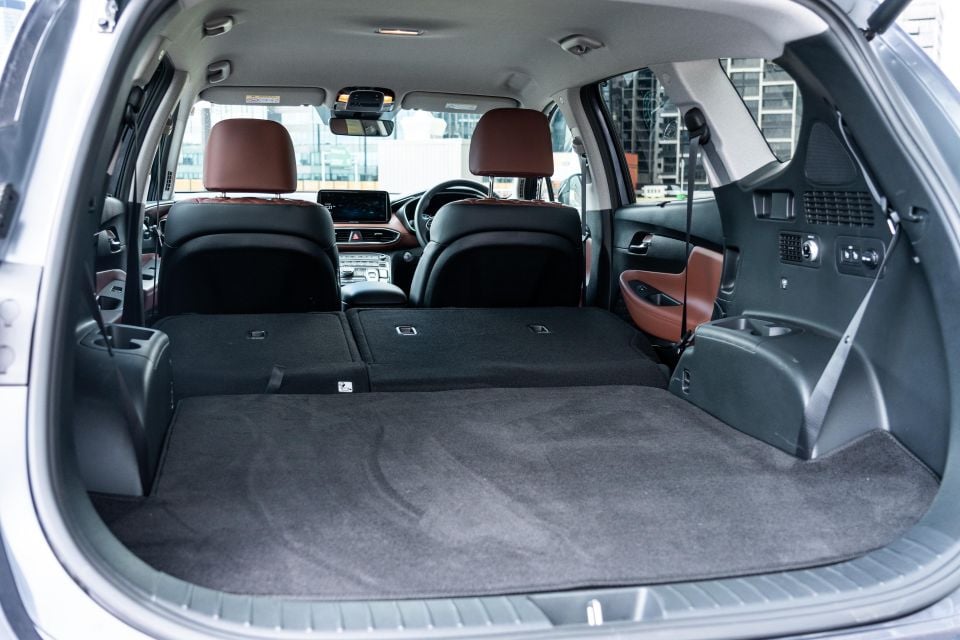
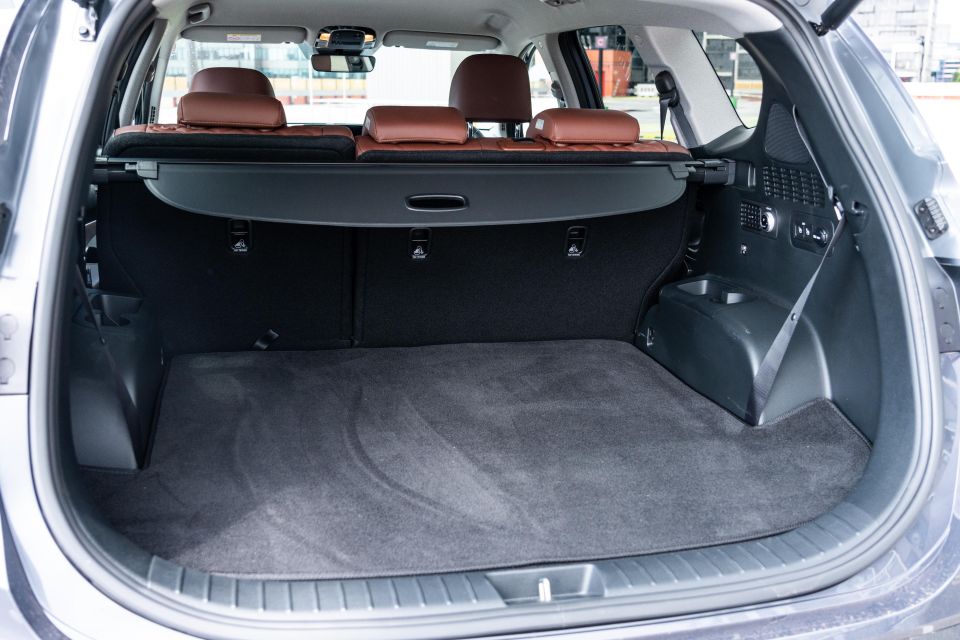
The second row is split in two with both sides able to slide to free up more space for third-row occupants. Third-row occupants also have cupholders, vents, fan speed controls, a single 12V outlet and a single USB-A outlet.
With the third row up, there’s 130L of space – scarcely enough for a typical suitcase. Drop that row and there’s 571L of space, though you can expand this to 782L by sliding the second row forward.
Press the buttons to drop the second row and there’s 1649L. A full-size spare is located under the vehicle, not exactly common nowadays as more and more cars offer space-saver spares or mere tyre repair kits.
The Santa Fe Hybrid uses a turbocharged 1.6-litre four-cylinder engine producing 132kW of power and 265Nm of torque, mated with a 44.2kW/264Nm electric motor and a 1.49kWh lithium-ion polymer battery.
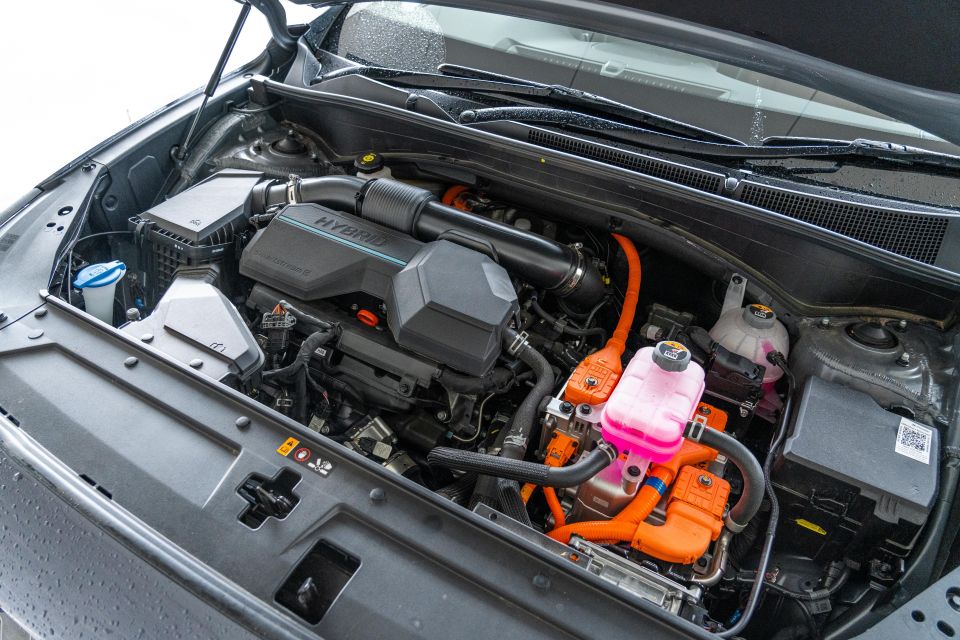
Total system outputs are 169kW at 5500rpm and 350Nm between 1000-4500rpm.
It uses a six-speed automatic transmission and active on-demand all-wheel drive.
The official combined cycle fuel economy claim is 6.0L/100km – just 0.1L thriftier than the diesel – and over a mix of inner-city, suburban and highway driving we averaged 5.9L/100km.
On one trip, consisting mostly of highway driving, we saw as low as 5.4L/100km, though the typical highway commute each day saw the Santa Fe Hybrid recording fuel economy in the low 6s.

Fuel economy in the low 6s is also what we observed in the slightly smaller GWM Haval H6 and Nissan X-Trail e-Power hybrids, so this is thrifty for a three-row SUV. It’s worth noting on a similar loop, we averaged 5.9L/100km in a Kluger hybrid, so the Santa Fe is more than competitive.
Unlike a Kluger, it’s rated to run on 91RON regular unleaded fuel, which helps keep running costs low. The fuel tank measures 67 litres.
The Hybrid does take a hit in terms of towing capacity over petrol and diesel models, with the braked towing figure dropping from 2500kg to 1650kg.
If you’re coming out of a hybrid Kluger, the Santa Fe Hybrid will feel a bit different. The petrol engine will sometimes fire earlier than in the Kluger, but conversely you’ll sometimes see the EV light come on during high-speed driving.
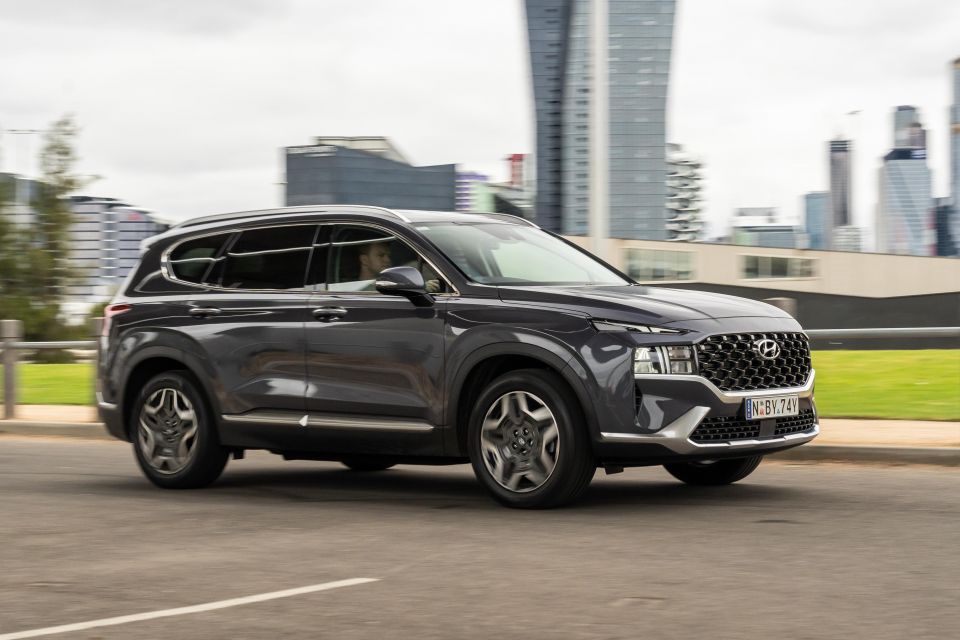
There’s also no button for an EV-only mode, though in the Kluger this cuts out the second you apply too much throttle or exceed a certain speed anyway.
When only the electric motor is running, there’s a ghostly vehicle sound to warn pedestrians you’re on the move.
While the transitions to and from electric power can be a little less predictable than in a Toyota, they’re generally smooth and there’s also none of the e-CVT slurring in the Santa Fe due to the use of a traditional automatic.
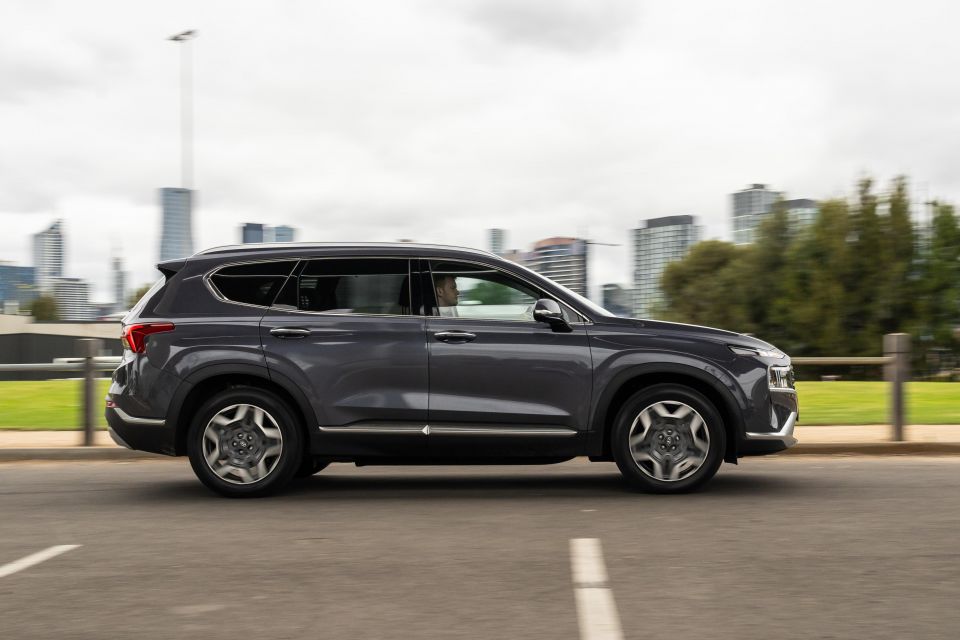
The shifts are smooth and but for a tendency to hunt for gears a tad much on hilly roads, we have no complaints with this transmission. The push-button gear selector isn’t as pleasant to use as a traditional shifter or rotary dial, however.
The Santa Fe Hybrid is punchy, and though it won’t push you back in your seat it has more than enough power to get out of its own way.
The engine note is inoffensive. It’s not the most inspiring sound, but it’s not as gruff as some of Hyundai’s four-cylinder engines.
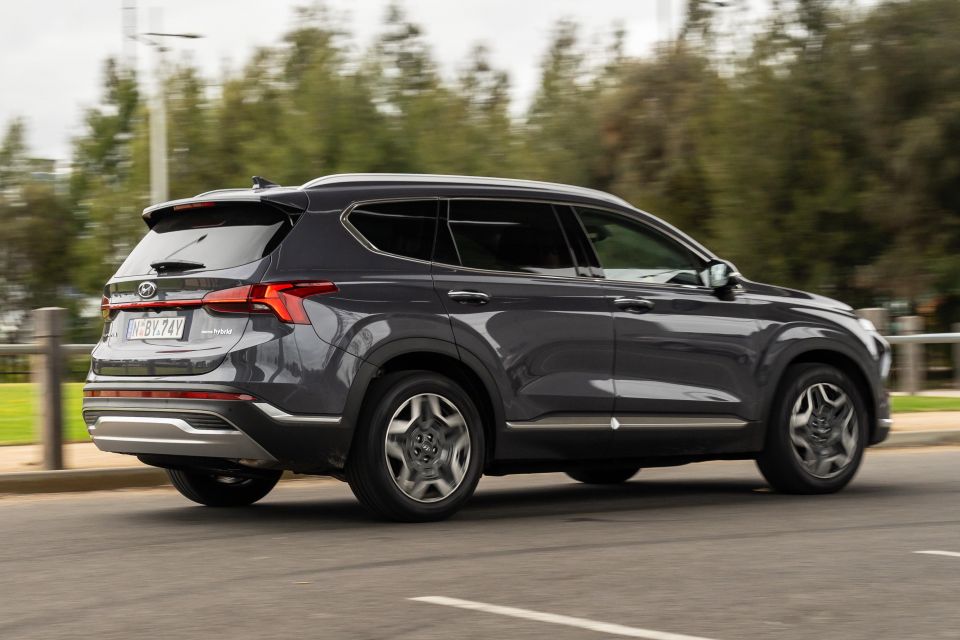
Ride comfort is excellent. It’s less floaty than a Kluger and yet is impressively damped, with bumps well absorbed – it feels poised, yet comfortable.
The Santa Fe Hybrid is a good steer. The steering is perhaps a touch heavier than expected of a vehicle in this segment and road feel isn’t abundant, but the tiller is overall quite confidence-inspiring.
Body roll is well-controlled for a vehicle this size and the Santa Fe Hybrid overall feels balanced and surprisingly nimble for a larger crossover. This is larger than a Toyota RAV4, but it doesn’t feel it.

Where expert car reviews meet expert car buying – CarExpert gives you trusted advice, personalised service and real savings on your next new car.
You can pop the Santa Fe Hybrid into Sport mode which adds some artificial steering resistance and holds onto gears a bit longer. It doesn’t do the latter in an obnoxious manner, unlike some cars’ Sport modes, but we didn’t feel the need to use this drive mode. We also didn’t bother with the paddle shifters, though they are pleasantly tactile.
In addition to Eco, Sport and Smart drive modes, there are also Snow, Mud and Sand terrain modes.
On the highway, the Santa Fe Hybrid’s cabin is quiet with only a hint of wind noise entering the cabin.
Hyundai’s Lane Following Assist is usually exceptional at keeping its vehicles centred in a lane, but the calibration seems a bit off in the Santa Fe Hybrid. The lack of camera-based traffic sign recognition is a bit disappointing.
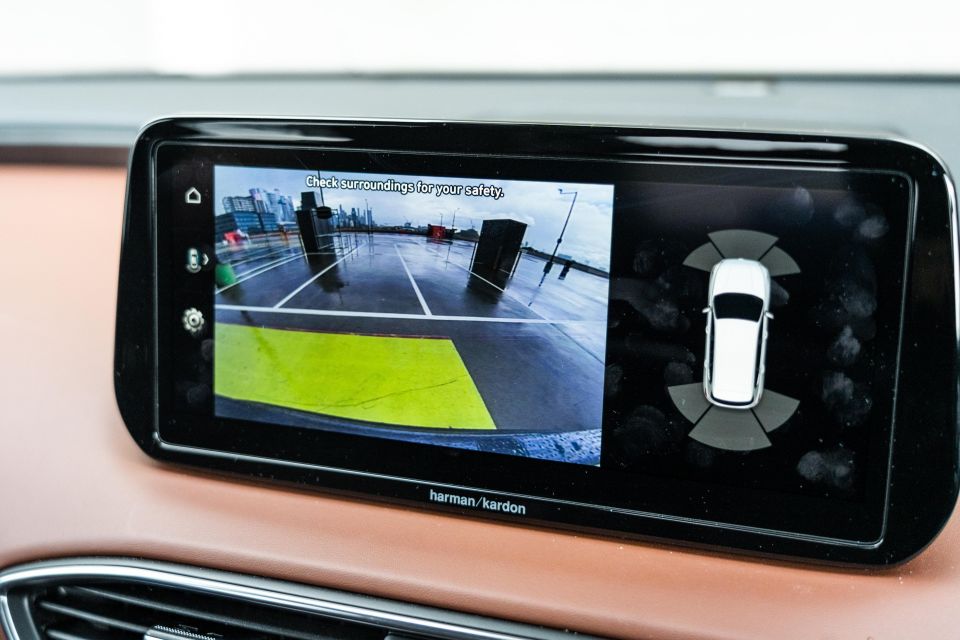
Santa Fe Elite Hybrid highlights:
It’s a pretty comprehensive equipment list, though if you want all the fruit you can step up to the Highlander. It adds features like ventilated front seats, a head-up display, panoramic sunroof, and Nappa leather upholstery.
While petrol and diesel versions of the Santa Fe have a five-star ANCAP safety rating, based on testing conducted in 2018, hybrid models remain unrated.

Santa Fe petrol and diesel models received an adult occupant protection score of 94 per cent, child occupant protection score of 86 per cent, pedestrian protection score of 67 per cent, and safety assist score of 78 per cent.
Standard safety features include:
Notably, the blind-spot and rear cross-traffic features will actively intervene if a collision is detected. In many rivals, these are simply alerts.
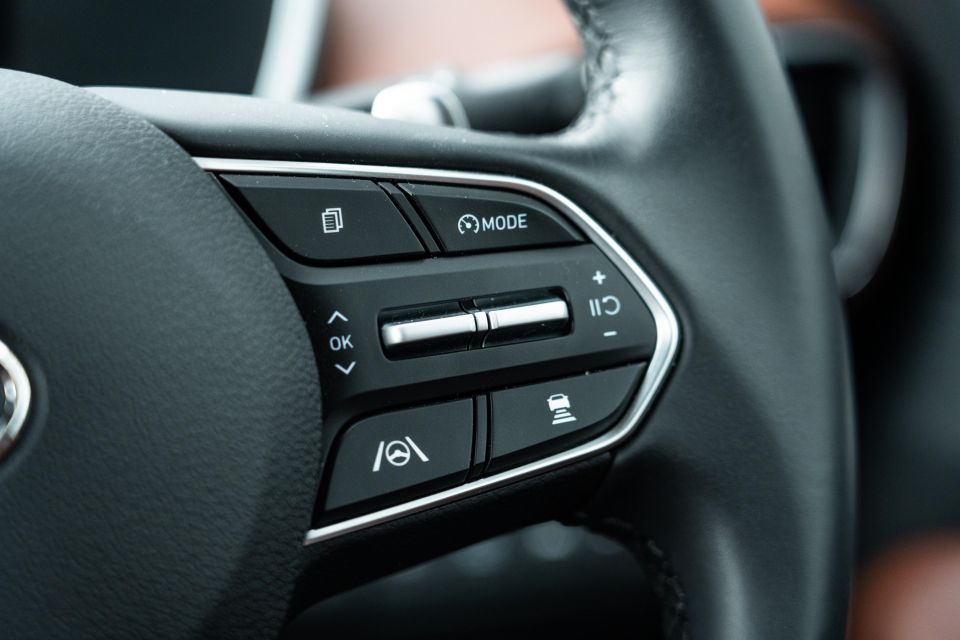
Also included are Hyundai’s Safe Exit Assist, which actively prevents occupants from opening a door into oncoming traffic, and a rear seat occupant alert which uses radar to detect if you’ve left anybody in the back seat and notifies you if you try to lock the car with them inside.
Stepping up to the Highlander nets you rear AEB, a surround-view camera, and Hyundai’s Blind-Spot View Monitor and Remote Smart Parking Assist.
The Santa Fe is backed by a five-year, unlimited-kilometre warranty, while the high-voltage battery is covered for eight years or 160,000km.

Servicing is required every 12 months or 10,000km, with the first five services capped at $459 each, or $2295 all up.
Not only are those intervals shorter than a Kluger hybrid (12 months or 15,000km), each service costs more. The Toyota’s first five visits to the servicing department will set you back $265 each, or $1325 over five years.
However, the Santa Fe does look better against its Kia Sorento cousin. It has the same servicing intervals, but its first five visits are capped at $329, $669, $402, $985 and $370 ($2755 in total).
The Hyundai Santa Fe Hybrid makes a lot of sense when compared with key rivals.
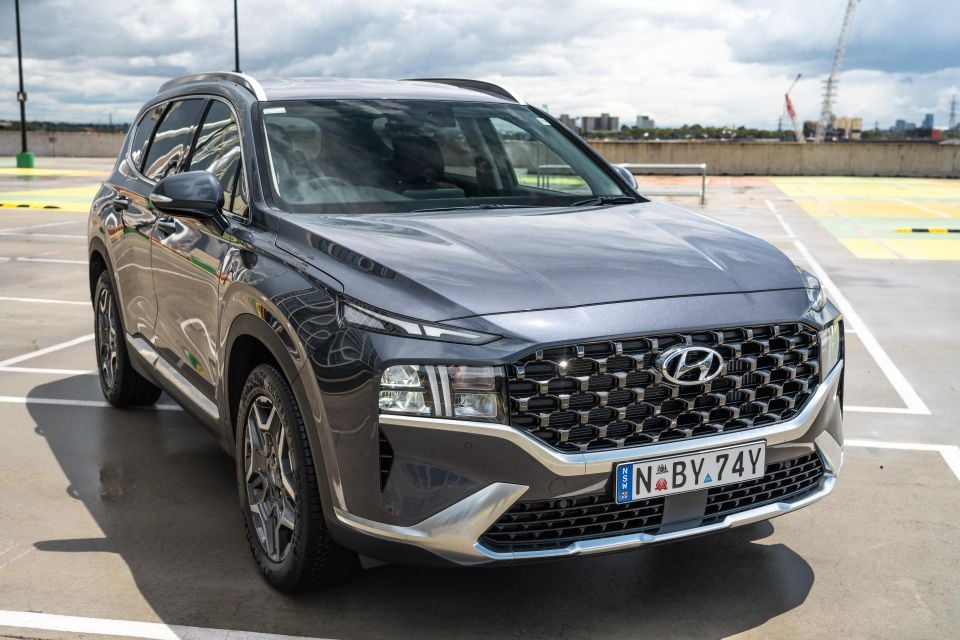
It has a classier interior than a Kluger, is more readily available than a Sorento, and offers similarly impressive fuel economy to both.
I don’t mind the styling but it won’t be to everyone’s taste. That said, the Kluger is no beauty queen, either. And while the hybrid powertrain has a very different feel to Toyota’s, the end result is the same: excellent fuel economy. A pity the Hyundai is costlier to service.
Against its own stablemates, the case for the Santa Fe Hybrid is a little weaker. Hyundai charges a steep premium over the diesel model for virtually identical fuel economy, and while the Hybrid is smooth and refined, the diesel is no tractor.
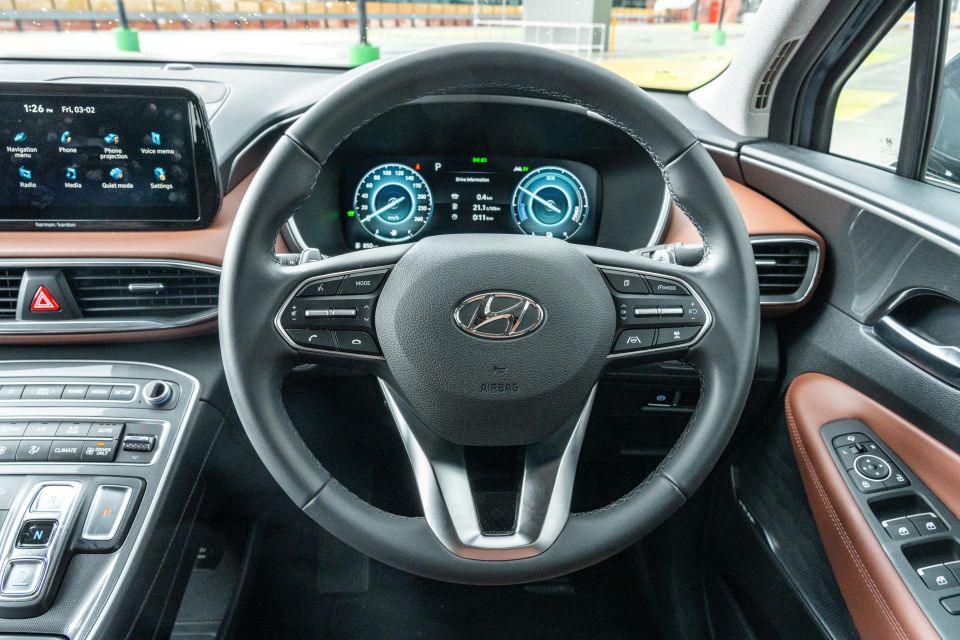
If you must have a three-row hybrid SUV, however, the Santa Fe is a compelling choice.
It has all the strengths of other Santa Fe models like balanced handling, polished ride quality, an attractive interior (with buttons!) and a long list of standard equipment.
It stacks up remarkably well for a vehicle that’s at the very end of its lifecycle.
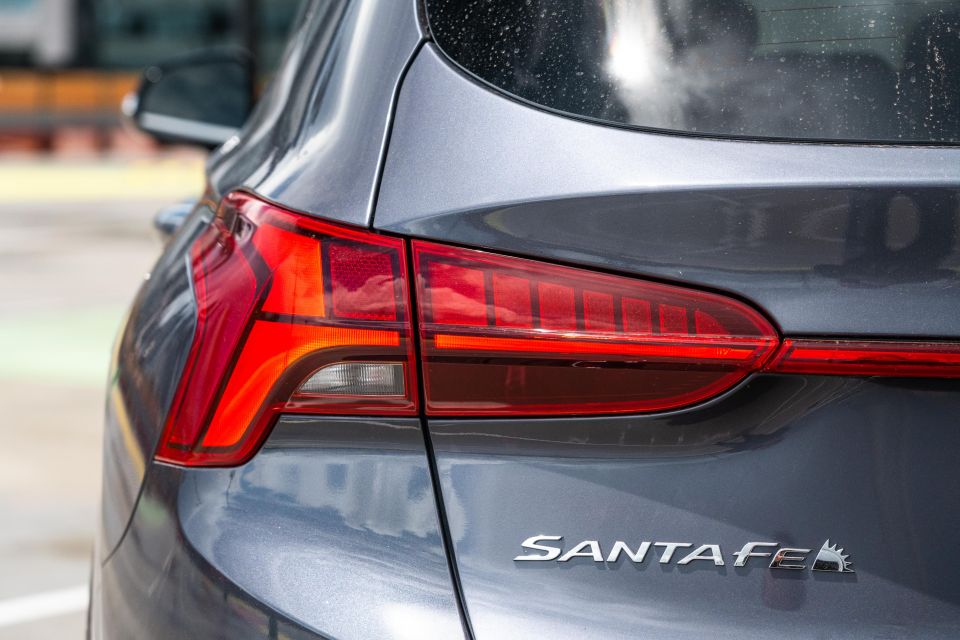
Click the images for the full gallery
Where expert car reviews meet expert car buying – CarExpert gives you trusted advice, personalised service and real savings on your next new car.
William Stopford is an automotive journalist with a passion for mainstream cars, automotive history and overseas auto markets.


William Stopford
1 Day Ago


Matt Campbell
1 Day Ago


William Stopford
2 Days Ago


CarExpert.com.au
5 Days Ago


Max Davies
6 Days Ago


Damion Smy
7 Days Ago